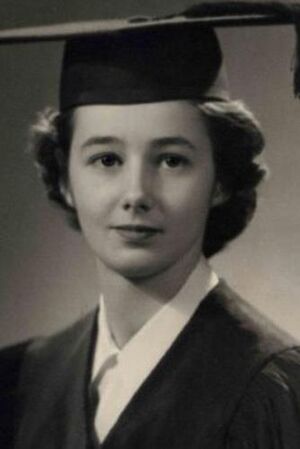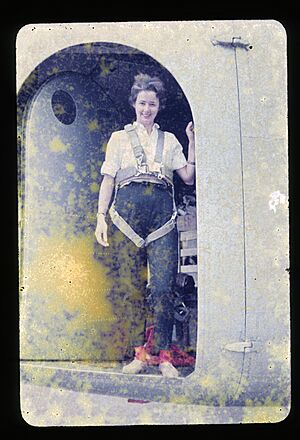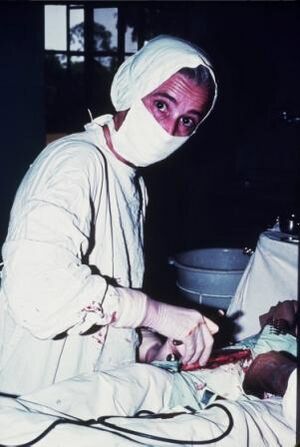Lucille Teasdale-Corti facts for kids
Quick facts for kids
Lucille Teasdale-Corti
|
|
|---|---|
 |
|
| Born | January 30, 1929 Montreal, Quebec, Canada
|
| Died | August 1, 1996 (aged 67) Besana in Brianza, Italy
|
| Nationality | Canadian by birth, acquired Italian citizenship upon marriage |
| Occupation | Medical doctor and pediatric surgeon |
| Known for | Pediatric surgeon who devoted her professional career to working in Lacor Hospital (Northern Uganda) with her husband |
| Awards | 1982 Order of Merit of the Italian Republic (Gov. of Italy)
1987 Frederick Newton Gisborne Starr Award (Canadian Medical Association) 1991 Order of Canada (Gov. of Canada) 1995 National Order of Quebec (Gov. of the Prov. of Quebec) 1995 Honorary Fellow (The Royal College of Physicians and Surgeons of Canada) 1995 Antonio Feltrinelli Prize (Accademia Nazionale dei Lincei Rome) 1996 Doctorate Honoris Causa (University of Montreal) 2000 A commemorative stamp is issued within the Millennium Collection (Canada Post) 2004 In memoriam Gold Medal Order of Civil Merit (Gov. of Italy) |
Lucille Teasdale-Corti CM GOQ (January 30, 1929 – August 1, 1996) was a Canadian doctor and children's surgeon. She worked in Uganda from 1961 until she passed away in 1996. Even with many challenges, like civil war and the AIDS epidemic, she and her husband helped start a hospital in northern Uganda.
Biography
Lucille Teasdale was born in Montreal, Quebec, on January 30, 1929. She was the fourth of seven children. Her father was a kind butcher in a working-class part of Montreal.
In 1941, she went to a Catholic high school. It was run by nuns who were dedicated to education. When she heard stories from nuns who had worked as missionaries in China, she decided at age 12 to become a doctor "in the Indies."
She won a scholarship to study medicine at the University of Montreal in 1950. In her class of 110 students, only ten were women. Eight of these women continued their studies after the first year. She graduated with honors in 1955. She then completed her internship at Sainte-Justine Hospital in Montreal. This hospital specialized in children's and mothers' health.
During her internship, she met Italian doctor Piero Corti. He was also training in pediatrics. Both doctors wanted to work where help was most needed. But, as Corti said, "she was always much too busy for anything else but work."
After her internship, Lucille Teasdale began training to become a children's surgeon in 1958. She did her first two years of training in Montreal. She wanted to finish her training abroad, so she applied to hospitals in the United States. However, she was turned down. Her biographer, Michel Arseneault, said some hospitals refused her because she was a woman.
In 1960, Lucille Teasdale went to France to complete her final year of training. She worked at a hospital in Marseille.
Uganda Mission
While working in France, Lucille Teasdale sent a postcard to Piero Corti. She invited him to visit. Piero had chosen to work at a small 30-bed mission hospital near Gulu in Northern Uganda. He was getting ready to send the first air cargo of medical equipment. He invited Lucille to go with him "just for a couple of months" to help start the surgery department. He could only pay for her travel and cigarettes. Lucille agreed and flew to Uganda on the same Italian Air Force plane.
When Lucille arrived in Uganda in 1961, she needed a license to practice medicine. She learned she would first have to do two months of internship. She was sent to a surgeon at Mulago University Hospital in the capital. This surgeon, Dr. Denis Parsons Burkitt, interviewed her. He then allowed her to go straight to Lacor Hospital. Dr. Burkitt was famous for studying a type of children's cancer called Burkitt's lymphoma.
St. Mary’s Hospital Lacor, or simply Lacor Hospital, is a non-profit hospital. It was started by Catholic missionaries in 1959. It is about 5 kilometers west of Gulu, the main town in Northern Uganda. When Lucille joined Lacor, the hospital had a 40-bed maternity ward and an outpatient department. Other parts, like the operating room, were still being built. Piero had chosen this hospital because the Italian bishop who owned it agreed to let him manage and develop it. Piero would raise all the money needed himself.
Lucille's first operation at Lacor was done on an examination bed. She spent mornings visiting patients in the wards. Afternoons were spent in the operating room. She extended her stay because Piero needed to return to Italy. Lucille then went back to France. She returned to Uganda in December 1961 after Piero asked her to marry him. They got married in the hospital's chapel on December 5, 1961.
Piero and Lucille shared a dream that guided them throughout their lives. It is still the hospital's main goal: "to offer the best possible care to the greatest number of people at the lowest possible cost" and "to train those who would replace them."
On October 9, 1962, Uganda became an independent country. On November 17, 1962, Lucille gave birth to her only child, a daughter named Dominique. Locals called her Atim, which means "born far from home" in the Acholi language. From then on, Lucille was known locally as "min Atim," meaning mother of Atim. At that time, the hospital staff included Italian nuns who were trained nurses and midwives. Local people were also trained on the job.
For over 20 years, Piero and Lucille helped train new Italian doctors. These doctors came to Uganda for two years of community service instead of military service. They worked in various mission and government hospitals in northern Uganda, including St. Mary's. These hospitals relied heavily on these doctors.
In 1971, Idi Amin Dada took power in Uganda. In 1972, Amin expelled 60,000 Asians from the country. This caused the country's economy and services to collapse. Piero and Lucille had to decide whether to leave, like most foreign workers. They chose to stay and keep the hospital running. Piero's family in Italy helped by sending containers of supplies. These included medicines, equipment, and used clothes.
However, they made the hard choice to send their daughter away. This was for her safety and education, as the school system was failing. Dominique had lived at the hospital since birth. Lucille often took her to the wards and operating room. Now, Dominique would only return to Lacor for holidays. She went to live with an aunt in Italy, then to a boarding school in Kenya. Lucille had only one condition when she married Piero: their family would never be separated. She said sending her daughter away was the biggest sacrifice she ever made.
The hospital faced serious danger during the Uganda-Tanzania War in 1979. This war led to Idi Amin's overthrow. The hospital was attacked many times by Amin's soldiers. During these months, the hospital was cut off from the rest of the world. Lucille performed many operations on wounded soldiers and victims of tribal conflicts. Piero was also injured and almost shot during these attacks. When the Tanzanian army arrived, a commander said Lacor was the only hospital they found open and working in 600 kilometers.
In 1980, civil war broke out in Uganda. Over 500,000 Ugandans died during this time. Vast areas of land were destroyed.
In 1982, people with a mysterious "slim" disease started coming to Lacor Hospital. This disease was later known as HIV/AIDS. Lucille began to show symptoms of illnesses linked to AIDS. She tested positive for HIV in 1985, when tests became available in Italy. Piero and Lucille believed she got the infection in 1979. This was when Lucille was doing many surgeries on war victims. She often cut herself with sharp pieces of shattered bones during these operations.
In 1983, the Uganda Ministry of Health recognized Lacor as a training center for new doctors. These doctors could do their one-year internship at Lacor Hospital. Then they could stay and work there or at other non-profit hospitals. Lucille was at the forefront of training these young doctors. Many of them later became important leaders at Lacor Hospital and in Uganda's health system.
In 1986, a new rebel group called the Lord’s Resistance Army (LRA) emerged in Northern Uganda. From 1986, rebels often looted the hospital at night. They held staff and patients at gunpoint. Piero and Lucille were also held at gunpoint several times in their home. When the rebels couldn't find what they wanted, they kidnapped nurses for ransom. Most staff lived within the hospital compound for safety. They often went to work at night in regular clothes to avoid being recognized and kidnapped. This brave dedication by the staff continued for years.
In 1989, rebels entered the hospital looking for "Dr. Corti and Min Atim" (Piero and Lucille). The couple had just left for a holiday. Dr. Matthew, a brave doctor, offered himself as the person in charge. He was taken away with other staff. Piero and Lucille returned right away and decided to close the hospital. However, local elders begged them not to. They said the hospital was the only thing left to them. They promised to convince the rebels not to enter again. For the next fifteen years, the hospital did not experience another rebel attack, even as the conflict raged around it. The hospital built a wall to protect those inside from bullets.
Lucille Teasdale was diagnosed with AIDS in 1985. She continued to work despite her declining health. She focused on the adult outpatient and AIDS/TB department. She slowly handed over operations to the Ugandan doctors she had trained. She suffered from many health problems. These included constant mouth infections that made eating hard. She also had serious conditions like Addison’s Disease and a type of pneumonia. Piero often had to rush her to London or Milan for treatment. A few months before she died, she weighed only 40 kg. Yet, she was still doing 4 to 6 hours of outpatient clinics every day. Sometimes she was too weak to get up. Piero or others would give her an IV to rehydrate her. As soon as she felt better, she would remove the needle and go to work.
In a last effort to help her worsening condition, Piero rushed Lucille to Italy. She died at their home in Besana in Brianza on August 1, 1996.
During her career at Lacor Hospital, she performed over 13,000 operations. In 1996, the hospital had 446 beds. It treated 13,437 admitted patients and 116,953 outpatients. Despite the conflict, they also delivered 1,114 babies, performed 1,278 major surgeries, and gave 33,613 vaccine doses.
Lucille Teasdale’s body was returned to Uganda. At that time, the conflict around the hospital was very bad. The military had flown her and Piero by helicopter when they left Lacor because the roads were too dangerous. Thousands of "night commuters," mostly children and women, sought shelter inside the hospital each night. Rebels raided villages to loot, kill, and kidnap children. Lucille's funeral service was held in the nearby Cathedral. Hundreds of people attended. Some staff walked up to 40 km from health centers, despite the risk of ambushes and landmines. The military even placed an armed tank outside the cathedral for protection. She was buried in one of the hospital’s courtyards.
Honours and Recognition
Lucille Teasdale received many awards and honors for her incredible work:
- 1972: Awarded Missione del Medico – Angelo De Gasperis with Piero Corti.
- 1982: Awarded the Order of Merit of the Italian Republic (Officer) with Piero Corti.
- 1986: Awarded the World Health Organization's Sasakawa Health Prize with Piero Corti. This prize is for outstanding work in health development.
- 1987: Awarded the Frederick Newton Gisborn Starr Award by the Canadian Medical Association.
- 1991: Awarded the Order of Canada.
- 1995: Named Honorary Consultant for the Ministry of Health of Uganda.
- 1995: Awarded the National Order of Quebec (Grand Officier).
- 1995: Awarded a Honorary Fellowship by the Royal College of Physicians and Surgeons of Canada.
- 1996: Awarded a Doctorate Honoris Causa by the University of Montreal.
- 2000: Canada Post issued a stamp in her honor.
- 2001: Inducted into the Canadian Medical Hall of Fame.
- Several places in Quebec, Canada, are named after her, including parks, schools, and roads.
Images for kids
See also
 In Spanish: Lucille Teasdale-Corti para niños
In Spanish: Lucille Teasdale-Corti para niños






